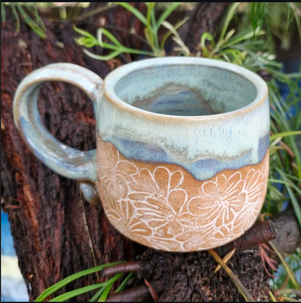Texture Rollers in the Studio

Blog by @cilla_ceramics
Texture rollers are a fantastic addition to bring visual interest and tactile variety to clay surfaces. These tools are available in various designs and can be made from rubber, wood, or plastic. Create intricate floral patterns or simple geometric designs with texture rollers that offer endless possibilities for enhancing your work. Let’s dive into how these versatile tools can elevate your pottery practice!
Why Use Texture Rollers?
Texture rollers are an easy and efficient way to add detail to your clay pieces. Unlike hand-carving or stamping individual textures, rollers allow you to quickly cover large areas with consistent patterns.
This makes them perfect for:
Functional Pottery: Adding visual interest to mugs, tiles bowls, or plates.
Decorative Pieces: Crafting wall hangings or ornamental items with more complex patterns.
Experimenting with Surface Design: Testing out different textures without committing to detailed handwork.
Types of Texture Rollers
When choosing a texture roller, consider the firmness of your clay body, the desired depth of impression, and whether you want a continuous pattern or a single motif. Texture rollers come in a wide array of designs and materials, each lending itself to different effects on clay:
Rubber Rollers: provide a flexible clean impression without sticking to the clay.
Wooden Rollers: Known for their durability which is ideal for creating deep, consistent impressions on soft slabs.
Acrylic/ Plastic Rollers: Very lightweight and usually 3D printed offering unique, organic patterns that can’t be replicated.
Each type of roller gives a different quality of impression, so experimenting with various materials is encouraged to find what works best for your studio.
Texture Rollers on Clay
Using texture rollers is a fairly straightforward process. Here are some helpful tips for best results:
Clay surface: whether slab or wheel thrown, clay that is smoothed will result in a crisp image avoiding unwanted marks or bumps. That’s not to say they shouldn’t be used on groggy clay.
Roll Evenly: Place the roller at one end of your piece and roll with steady pressure. Too much pressure can distort the shape, while too little may result in faint impressions.
Experiment with Direction: Changing the angle or direction of your roller can create interesting, layered textures.
Creative Uses for Texture Roller
There are numerous ways to incorporate texture rollers into your pottery. Here are some ideas:
Layered Textures: Use multiple rollers on a single piece to achieve complex, overlapping textures.
Spot Texture Application: Roll only parts of your piece, such as the rim of a bowl or handle of a mug, to highlight certain areas.
Combine with Glazes: Textured surfaces offer fantastic opportunities for glazing. Experiment with glazes that accentuate the texture, like those that break over high points or pool in the impressions.
Patterned Tiles: For functional or decorative wall tiles, texture rollers can create consistent, repeatable patterns perfect for larger surfaces.
Caring for Your Texture Rollers
Texture rollers are relatively low-maintenance, but keeping them in good shape will ensure long-lasting use:
Clean Immediately: If clay or other materials stick to the roller, clean it right away to prevent build up.
Store Properly: Store rollers in a dry place, especially wooden ones, to prevent warping or cracking.
Avoid Excessive Pressure: Over time, pressing too hard on delicate rollers may wear down intricate designs, so use a moderate touch.
Final Thoughts
Incorporating texture rollers into your studio practice opens up new possibilities for creativity and expression. From streamlined, functional pieces to complex, layered designs, they offer potters of all levels a way to explore surface texture with ease and efficiency. So, the next time you’re looking to add an extra dimension to your work, reach for a texture roller and let your imagination guide you.

